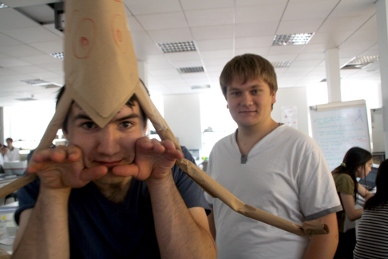Team:Cambridge/Blog/Week 3
From 2011.igem.org
Week 3 : 11th of July to 17th of July
Monday
The day begins with assembling our amplified DNA into working plasmids in order to transform Bacillus. Several mislabelled tubes and much all-round amateurishness later the task is complete and the day's brainstorming begins. Our possible projects are by now narrowed down to four which show some promise. It seems hopeful that a final choice can be made soon.
Tuesday
Our mini-projects continue apace with transformation of (hopefully) working plasmids into E. coli for amplification (the bacteria reproduce, making more of our DNA at the same time). The team are introduced to the lab's high-tech portable dark room for working with fluorescence: a customisable, cubic, fully-opaque, stiffened wood-fibre local micro-environment device (known in the trade as a cardboard box).
The team's ideas converge further and seem to centre on reflectin - a protein with highly unusual properties isolated only relatively recently from a class of squid. Enthusiasm is higher than ever with a focus for our efforts.
Wednesday
The mini-projects amble gently in the direction of a conclusion - one group successfully manages to transform E. coli with the GFP fusion vector. Interestingly for a Bacillus sporulation gene, transformed colonies appear to be expressing the fusion protein.
Excitement abounds about our new main project; quite some time is spent coming up with a punning project title cheesy enough to be worthy of iGEM - 'Bactiridescence' is unanimously decided upon.
The team has ambitiously decided to develop a DNA-editing program alongside the main project.
Thursday
The mini-projects reach an anticlimax perhaps only attainable in biological research - after much effort transforming Bacillus bacteria at last with our fusion vectors, all colonies fail to grow. No time is wasted on such things, however, since our main project needs planning out in great detail and there are few weeks until the Jamboree.
Luck seems to be on our side in an important way - reflectin is just characterised well enough that we can do clever things with it, like protein engineering. The team are hopeful that a speedy and successful expression in E. coli will leave time for use of such cleverness to make a fantastic biosensor.
Friday
The plan for the project is to explore structural colour in E. Coli, we think there are various ways we might control this in vivo and in vitro. In vivo control could rely on phosphorylation and dephosphorylation to tune the structural colour of the protein (as it does in the squid) . Whilst in vitro we hope to produce thin films which respond to water vapour, ethanol vapour and potentially an electric field The team are hopeful that our work could one day be linked to a biosensor, which will do what GFP likely never will (no matter how much we tinker with it) - give a response in real time to signal modulation.
Planning the project in detail is harder than many of us have thought, with many hours thrown after tracking down kinase consensus sequences and the like. With no time to flesh out the details, the team order a large delivery of squid (!) in order to get stuck in right away.
Saturday
Weary from our efforts at the biological coal-face, the team take a day off to visit the city of Ely. The Cathedral is well worth a visit - we were glad we did. Engineers particularly impressed, but in typical fashion don't know their gothic from their romanesque (they're clever, but engineers know nothing!).
 "
"

